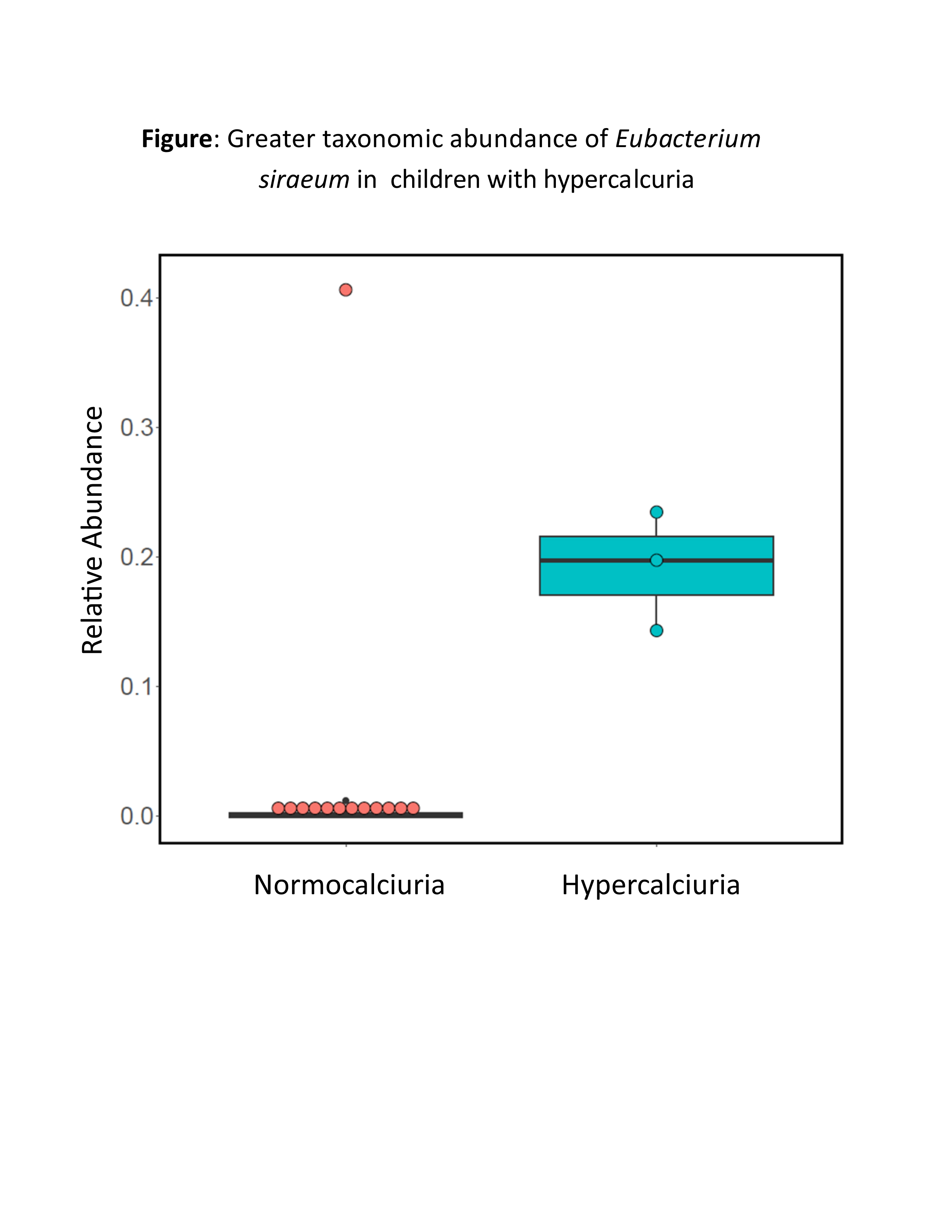Back
Introduction: The intestinal microbiome has been implicated in calcium oxalate kidney stone formation, thought to be driven predominantly through altered breakdown of dietary oxalate. The associations of the intestinal microbiome within sub-populations of kidney stone formers, however, is not well described. We evaluated a pilot cohort of children with nephrolithiasis comparing patients based on recurrent kidney stone episodes and abnormal 24-hour urinary parameters.
Methods: Children aged 6-18 with a history of nephrolithiasis, without an active ureteral calculus or antibiotic exposure within 30 days of study entry were eligible to participate. All participants had a 24-hour urine study within 6 months of study entry and provided a fecal sample. Microbiome samples were analyzed using 16S ribosomal DNA sequencing techniques for alpha and beta diversity comparing initial and recurrent stone formers as well as microbiome multivariate association (MaAsLin2) , using a general linear model with fixed effects. Shotgun sequencing reads were aligned to custom oxidase degradation and butyrate production gene databases (5 databases total). Comparisons for MaAsLin2 and shotgun metagenomics, normalized to sequencing depth, were based on stone recurrence, sex, hypercalcuria ( < 4 mg/kg/day), hyperoxaluria (> 45 mg/1.73 m2), and hypocitraturia ( < 310 mg/1.73 m2 [females] or < 365 mg/1.73 m2 [males]).
Results: A total of 16 enrolled children provided samples sufficient for analyses, including 9 girls and 7 boys, of whom 5 had experienced recurrent kidney stone events. Three participants had hypercalcuria, 2 had hyperoxaluria, and 4 had hypocitraturia. Alpha and beta-diversity did not differ across initial vs recurrent kidney stones. Exploratory analyses found Eubacteriumsiraeum to be significantly greater in relative abundance in children with documented hypercalciuria (Figure). There was no statistical difference in relative gene abundance between groups.
Conclusions: Comparisons across phenotypes of kidney stone disease in children revealed taxonomic differences associated with hypercalcuria. While the mechanisms of these differences are not well defined, these findings support further exploration into non-oxalate related mechanisms of lithogenesis related to the renal-gut axis. SOURCE OF
Funding: Research Affairs Committee Pilot Grant

Podium Session
Session: PD06: Pediatrics I
PD06-02: The Intestinal Microbiome Varies Across Phenotypes of Pediatric Nephrolithiasis
Friday, April 28, 2023
9:40 AM – 9:50 AM CST
Location: S501C

Jonathan S. Ellison, MD (he/him/his)
Medical College of Wisconsin & Children's Wisconsin
Podium Presenter(s)
Introduction: The intestinal microbiome has been implicated in calcium oxalate kidney stone formation, thought to be driven predominantly through altered breakdown of dietary oxalate. The associations of the intestinal microbiome within sub-populations of kidney stone formers, however, is not well described. We evaluated a pilot cohort of children with nephrolithiasis comparing patients based on recurrent kidney stone episodes and abnormal 24-hour urinary parameters.
Methods: Children aged 6-18 with a history of nephrolithiasis, without an active ureteral calculus or antibiotic exposure within 30 days of study entry were eligible to participate. All participants had a 24-hour urine study within 6 months of study entry and provided a fecal sample. Microbiome samples were analyzed using 16S ribosomal DNA sequencing techniques for alpha and beta diversity comparing initial and recurrent stone formers as well as microbiome multivariate association (MaAsLin2) , using a general linear model with fixed effects. Shotgun sequencing reads were aligned to custom oxidase degradation and butyrate production gene databases (5 databases total). Comparisons for MaAsLin2 and shotgun metagenomics, normalized to sequencing depth, were based on stone recurrence, sex, hypercalcuria ( < 4 mg/kg/day), hyperoxaluria (> 45 mg/1.73 m2), and hypocitraturia ( < 310 mg/1.73 m2 [females] or < 365 mg/1.73 m2 [males]).
Results: A total of 16 enrolled children provided samples sufficient for analyses, including 9 girls and 7 boys, of whom 5 had experienced recurrent kidney stone events. Three participants had hypercalcuria, 2 had hyperoxaluria, and 4 had hypocitraturia. Alpha and beta-diversity did not differ across initial vs recurrent kidney stones. Exploratory analyses found Eubacteriumsiraeum to be significantly greater in relative abundance in children with documented hypercalciuria (Figure). There was no statistical difference in relative gene abundance between groups.
Conclusions: Comparisons across phenotypes of kidney stone disease in children revealed taxonomic differences associated with hypercalcuria. While the mechanisms of these differences are not well defined, these findings support further exploration into non-oxalate related mechanisms of lithogenesis related to the renal-gut axis. SOURCE OF
Funding: Research Affairs Committee Pilot Grant

